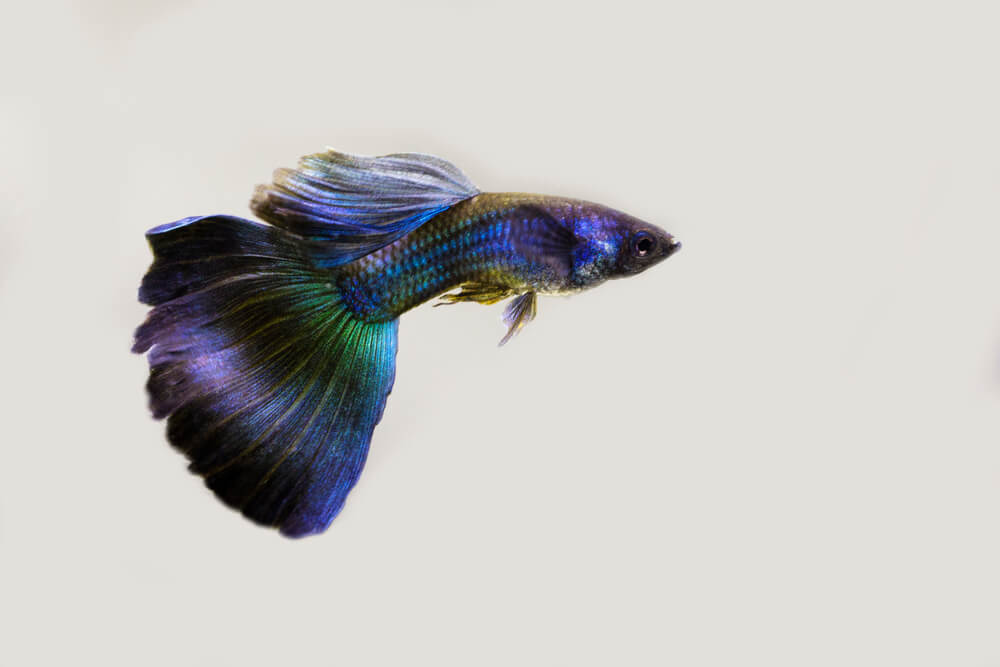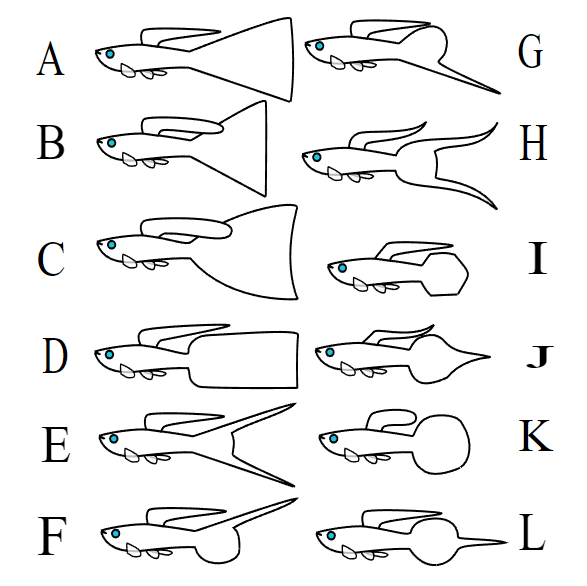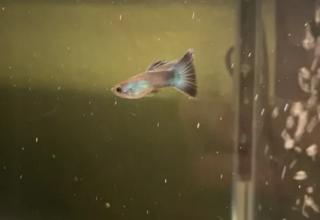Purple Moscow Guppy Care: Tank Mates, Breeding, Disease & Lifespan
Posted by Miles Harrison on 09/30/2022
We use affiliate links and may receive a small commission on purchases.
Purple Moscow Guppies are some of the rarest and most unique-looking guppy fish in the freshwater aquarium hobby.
These fish are peaceful, attractive, and easy to care for, making them excellent fish for beginners who are new to the hobby.
In this guide, you’ll learn all there is to know about caring for Purple Moscow Guppies. We’ll discuss diet, common diseases, tank mates, lifespan, and even breeding!
Let’s begin.
Species Summary
Chances are, you probably haven’t seen this unique guppy strain in person. If you have, consider yourself lucky, because the Purple Moscow Guppy is one of the rarest guppy strains in the hobby. Originally bred by Russian breeders, breeding of the species has become more popular in the United States, as well as in Indonesia.
These fish are a variant of the guppy (Poecilia reticulata), largely considered to be one of the most popular freshwater aquarium fish species.
🛒 Shop Freshwater Fish on Light Fish
In the wild, these fish can be found on almost every continent, except Antarctica. Guppies are typically introduced as a form of mosquito control, but recent studies have shown that these fish have made a negative impact on native fish populations.
Guppy fish are also capable of acclimating to salt water, and will also live in brackish conditions.
Luckily for native fish populations, Purple Moscow Guppies, and most aquarium guppies, are bred in captivity. The high demand for this fish has produced a variety of different strains, but few are as stunning as the Purple Moscow.

Appearance
Purple Moscow Guppies are quite small, and they typically range between 0.6-1.4 inches in length.
They have flowing veil tails, and purebred versions of this fish will have purple bodies that are rich in color. Juvenile males tend to be blue but will turn into a much darker purple as they age. Females will display purple fins but typically have gray bodies.
Guppy Tail Standards
Guppy fish have a unique grading system for their tails, the grading system is as follows:
Veil Tail: A large, triangle-shaped pattern (A)
Triangle Tail: A small, triangle-shaped pattern (B)
Fan Tail: Fan-shaped pattern (C)
Flag Tail: Flag-shaped pattern (D)
Double Sword: A pattern featuring two pointed ends, that resembles two swords (E)
Upper Sword: A pattern that features a tail, where the upper portion of the tail resembles a sword (F)
Lower Sword: A pattern resembling the opposite of the Upper Sword tail pattern (G)
Lyre Tail: Similar to the double sword pattern, but the base of the tail has a square appearance (H)
Spade Tail: The tail resembles a spade, similar to what you would find in a deck of cards (I)
Spear Tail: The tail has a wide base, which eventually narrows to resemble the tip of a spear (J)
Round Tail: The tail has a circular pattern (K)
Pin Tail: The tail has a circular pattern, with a sword-like tip. (L)
Purebred Purple Moscow Guppies typically have Veil Tails. From a distance, you may even mistake this rare strain with the Purple Veil Tail Betta fish!

Lifespan
Guppy fish are a relatively short-lived species, and wild-caught guppy fish typically have a life expectancy of around 2 years.
In captivity, they tend to have a longer lifespan than their wild counterparts. Given a proper diet, and ideal water conditions, aquarists can expect Purple Moscow Guppies to live anywhere between 2-5 years.
General Purple Moscow Guppy Care
There’s a reason guppy fish are so popular, they are some of the easiest freshwater fish to keep in an aquarium. Similar to other color variants, the Purple Moscow Guppy is an incredibly hardy fish.
These fish are excellent for beginners and are quite tolerant of mistakes made by new hobbyists.
Of course, this does not mean they require no care at all. You should still be aware of the responsibilities that come with owning this wonderful species. Let’s get right into it!
Tank Size
Due to their small size, you do not need a big aquarium to house Purple Moscow Guppies. A good rule of thumb, is to have one gallon of water for each guppy you plan on keeping. So if you plan on keeping one guppy, have a one-gallon tank, if you plan on keeping 5 guppies, have a 5-gallon tank, and so forth.
Following this rule will ensure that your tank does not suffer from overcrowding, which can cause ammonia and nitrite spikes due to excess waste.
Don’t feel restricted by a smaller tank, if you want to purchase a large aquarium, go for it! Having a bigger tank means more water, and any detrimental changes in water chemistry will be more gradual as a result.
Water Parameters
You’ll want to make sure you’re doing your best to give your guppy fish the best life possible. One of the most important ways to do that is by making sure your water parameters are optimal.
Descendants of the Purple Moscow Guppy come from warm climates, where they live in small streams and pools of water.
These environments typically have hard water, where pH ranges are between 7.4-8.0. However, the nice part about owning guppies is that they are also tolerant of ranges outside of their native environment!
If you plan on keeping Purple Moscow Guppies, aim for the following parameters:
Temperature: 65°F;-82°F;
pH: 5.5-8.0
KH: 10-30 dkH
Your fish will do well as long as you're within these ranges.
Proper Filtration
As with almost all fish, you’ll want to have some form of filtration if you plan on keeping Purple Moscows.
New aquarists might be under the impression that a filter may not be needed when keeping guppies. Nothing can be further from the truth! We always recommend providing some sort of filtration when keeping fish.
Purple Moscow Guppies will appreciate a HOB (hang-on-back) filter or a reputable canister filter. Even though these fish produce a relatively low bioload, having proper filtration will help increase oxygen levels in the water column and will assist in filtering ammonia and nitrite.
It’s also important to examine the strength of your filter intake. Due to the small size of the Purple Moscow Guppy, we recommend wrapping your filter intake with a sponge mesh . The mesh material will reduce the strength of the intake current, and will also prevent any guppy fish from being sucked into the filter.
Common Diseases
Although Guppy fish are some of the hardiest available in the hobby, they are still susceptible to the same types of diseases that plague many freshwater aquarium fish. In fact, due to breeding, the Purple Moscow color variant is not as hardy as other strains of Guppy, so you’ll want to monitor your water chemistry more frequently.
Oftentimes the number one cause of these diseases is related to poor water conditions. Lack of care and aquarium maintenance results in poor water chemistry, which weakens the immune system of fish, making them susceptible to diseases, parasites, and fungal problems.
One of the most common stress-induced diseases in Purple Moscow Guppies is fin rot. If you’ve owned Betta fish before, you might have seen how this disease impacts the fish’s tail. Since Purple Moscow Guppies have veil tails, you’ll want to keep an eye out for this disease. Its impact can dramatically alter the appearance of your fish. It’s the last thing a Guppy owner wants to face after purchasing such a rare strain.
Another common fish disease is known as Popeye. As you might have guessed, this disease typically causes swelling in the fish’s eye, resulting in an eye that appears as if it popped out of the fish's head! If left untreated, it can cause permanent damage to the fish’s cornea, so you’ll want to address this problem as soon as possible.
Luckily, these diseases are relatively easy to treat. Perform 20-30% water changes every 3 days, and monitor the fish to see if the diseases improve. Typically Popeye will resolve itself once the water conditions have improved. Unfortunately with fin rot, the fin may never fully grow back. As long as conditions don’t worsen, your fish's health should improve over the next few weeks.
As with most diseases, prevention is the key to avoiding these ailments. Performing bi-weekly 40% water changes, and regularly monitoring water chemistry will prevent these diseases from afflicting your guppy fish.
What to Include in a Purple Moscow Guppy Aquarium
One of the most important purchases you can make is a reliable aquarium heater. Heaters will ensure that temperatures remain stable, and they can even encourage breeding!
If you live in a cold climate for a good portion of the calendar year, your Purple Moscow Guppies will greatly appreciate the temperature increase provided by an aquarium heater. Adding a thermometer will also allow you to keep an eye on the temperature, which should be between 65F;-82°F;
Now, let’s discuss substrate. Guppy fish are not very picky about the substrate, so you have plenty of options. Our number one choice for the Purple Moscow Guppy is CaribSea's eco-complete . We are huge fans of this nutrient-rich substrate, as its black color will create a nice contrast with the deep-violet body of a Purple Moscow. However, if a black substrate is not your thing, you can also try pool filter sand, or pea gravel.
Although Purple Moscow Guppies will tolerate an aquarium without decorations. We highly recommend adding live plants and other natural hardscapes, such as seiryu stones or driftwood.
Live plants can help purify the water in an aquarium. They will absorb excess nutrients, and prevent ammonia spikes from occurring. They may even serve as a nice resting spot for your Purple Moscows!
Guppies also enjoy swimming through caverns. If you’re feeling creative, you can try positioning natural stones to create small tunnels for your fish to swim through. Seeing guppies swim in and around the hardscape is exciting to see!
If going the natural route isn’t your thing, you can purchase fake plants. Just be sure that any sort of material you add is dull to the touch. Sharp materials can tear through the flowing fins of a Purple Moscow Guppy.
When it comes to lighting, these fish will do well with natural lighting. However, if you want to see your Purple Moscow shine, consider adding some LED lights. These lights will help showcase the beautiful violet colors of this guppy.

Food & Diet
Feeding guppies is quite simple. These fish will consume practically any fish-safe food introduced to the aquarium.
We recommend feeding Purple Moscow Guppies a diet consisting of primarily high-quality flakes or floating pellets.
You’ll want to feed your Purple Moscows at least twice a day, but be careful of overfeeding! Overfed fish can suffer from health issues, such as constipation. Even worse, leftover food will accumulate on the bottom of the aquarium, and will eventually convert into harmful ammonia.
Feed your fish enough food that they can consume in 2-3 minutes. Monitor your fish while feeding, if they seem uninterested in the food, you’ve probably fed them too much!
If you’d like, you can treat your Purple Moscow Guppies with the occasional bloodworms, or brine shrimp. These foods are quite nutritious and resemble their native diet, which largely consists of mosquito larvae.
Behavior & Temperament
Purple Moscow Guppies are laid-back fish. These fish are incredibly peaceful and will do well with other peaceful species, like Tetras.
These fish also love to school! When kept in groups, these fish will swim together. Usually, they will school as a defense mechanism, but occasionally they will do it at random, a fun sight to see in a home aquarium!
You may notice the occasional guppy wandering off on their own. These fish are quite curious and will wander away from the group to investigate potential new food sources.
Occasionally, these fish may try and nip at the fins of another Purple Moscow Guppy. Not to worry though, as this behavior is playful.
Tank Mates
Due to their peaceful nature, Purple Moscow Guppies will live quite comfortably with other fish. You can house both male and female guppy fish, but don’t be surprised if you start noticing territorial disputes. Males will compete for potential females, so aim to provide at least 2 female guppies for each male guppy..
If you choose to opt for a community tank, there is a large variety of peaceful fish that will go quite well with Purple Moscows. Some recommendations include:
- Platies
- Swordtails
- Honey Gouramis
- Harlequin Rasboras
- Green Neon Tetras
- Cardinal Tetras
- Emperor Tetras
- Otocinclus
- Orange Pumpkin Shrimp
Breeding
If you're fortunate enough to have a male and female Purple Moscow Guppy, the breeding process is relatively straightforward.
Guppies are livebearing fish, just like endlers and platies. This means that instead of laying eggs, the female will keep them in her womb. Once ready, she will release them directly as fry! Raising the fry will be the most difficult part when breeding these fish.
You’ll want to establish a breeding tank. In this tank, you should add plants, and other hiding spots for the fry to inhabit once they’re released. Transfer the pregnant female into this aquarium, and ensure water conditions are optimal. You don’t want any ammonia or nitrite in the water column, as it will affect the health of the fry.
Now, over the next 3 months, continue to perform weekly 20% water changes in the breeding tank. You can also feed the fry high-quality crushed flake food, baby brine shrimp, and microworms. You’ll need to feed Purple Moscow guppy fry five to eight times a day. As they grow, you can start increasing the amount of available food.
If you’ve kept the fry alive for 3 months, you can celebrate, as you’ve successfully bred Purple Moscow Guppies!
Where to Purchase
Purple Moscow Guppies are hard to find. You can purchase Purple Moscow Guppies from reputable sellers on Light Fish, and on other platforms such as eBay.
Many hobbyists have resorted to purchasing from breeders in Indonesia, where guppy breeding is quite common. These breeders often advertise their fish on social media, such as Instagram.
In Summary
We’ve covered a lot, and now you know all of the ins and outs when it comes to caring for Purple Moscow Guppies.
As long as you stay on top of feeding a high-quality diet, and performing weekly water changes, you’ll have great success with keeping this rare guppy strain.
If you have any questions or suggestions, we’d love to hear from you! You can send us an email, or even a direct message on Instagram!
December's Giveaways on Light Fish














